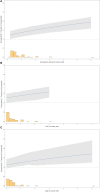Contribution of cats and dogs to SARS-CoV-2 transmission in households
- PMID: 37519992
- PMCID: PMC10375487
- DOI: 10.3389/fvets.2023.1151772
Contribution of cats and dogs to SARS-CoV-2 transmission in households
Abstract
Introduction: SARS-CoV-2 is known to jump across species. The occurrence of transmission in households between humans and companion animals has been shown, but the contribution of companion animals to the overall transmission within a household is unknown. The basic reproduction number (R0) is an important indicator to quantify transmission. For a pathogen with multiple host species, such as SARS-CoV-2, the basic reproduction number needs to be calculated from the partial reproduction numbers for each combination of host species.
Method: In this study, the basic and partial reproduction numbers for SARS-CoV-2 were estimated by reanalyzing a survey of Dutch households with dogs and cats and minimally one SARS-CoV-2-infected human.
Results: For households with cats, a clear correlation between the number of cats and the basic reproduction number (Spearman's correlation: p 0.40, p-value: 1.4 × 10-5) was identified, while for dogs, the correlation was smaller and not significant (Spearman's correlation: p 0.12, p-value: 0.21). Partial reproduction numbers from cats or dogs to humans were 0.3 (0.0-2.0) and 0.3 (0.0-3.5) and from humans to cats or dogs were 0.6 (0.4-0.8) and 0.6 (0.4-0.9).
Discussion: Thus, the estimations of within-household transmission indicated the likelihood of transmission from these companion animals to humans and vice versa, but the observational nature of this study limited the ability to establish conclusive evidence. This study's findings support the advice provided during the pandemic to COVID-19 patients to maintain distance from companion animals as a precautionary measure and given the possibility of transmission, although there is an overall relatively limited impact on the pandemic when compared to human-to-human transmission.
Keywords: COVID-19; companion animal; final size; mathematical model; multilevel transmission; multispecies; reproduction number; zoonosis.
Copyright © 2023 Fischer, Broens, Kooistra, De Rooij, Stegeman and De Jong.
Conflict of interest statement
The authors declare that the research was conducted in the absence of any commercial or financial relationships that could be construed as a potential conflict of interest.
Figures




Similar articles
-
The SARS-CoV-2 Reproduction Number R0 in Cats.Viruses. 2021 Dec 10;13(12):2480. doi: 10.3390/v13122480. Viruses. 2021. PMID: 34960749 Free PMC article.
-
Frequency of SARS-CoV-2 infection in dogs and cats: Results of a retrospective serological survey in Šumadija District, Serbia.Prev Vet Med. 2022 Nov;208:105755. doi: 10.1016/j.prevetmed.2022.105755. Epub 2022 Sep 13. Prev Vet Med. 2022. PMID: 36126551 Free PMC article.
-
Evidence of Exposure to SARS-CoV-2 in Dogs and Cats from Households and Animal Shelters in Korea.Animals (Basel). 2022 Oct 15;12(20):2786. doi: 10.3390/ani12202786. Animals (Basel). 2022. PMID: 36290173 Free PMC article.
-
[SARS-CoV-2 infections in cats, dogs, and other animal species: Findings on infection and data from Switzerland].Schweiz Arch Tierheilkd. 2021 Dec;163(12):821-835. doi: 10.17236/sat00329. Schweiz Arch Tierheilkd. 2021. PMID: 34881715 Review. German.
-
Disease Risk Assessments Involving Companion Animals: an Overview for 15 Selected Pathogens Taking a European Perspective.J Comp Pathol. 2016 Jul;155(1 Suppl 1):S75-97. doi: 10.1016/j.jcpa.2015.08.003. Epub 2015 Sep 28. J Comp Pathol. 2016. PMID: 26422413 Review.
Cited by
-
SARS-CoV-2 exposure in hunting and stray dogs of southern Italy.Vet Res Commun. 2024 Dec;48(6):4037-4042. doi: 10.1007/s11259-024-10496-9. Epub 2024 Aug 21. Vet Res Commun. 2024. PMID: 39167256 Free PMC article.
-
SARS-CoV-2 Seroprevalence in Indoor House Cats From the Lisbon Area During the COVID-19 Pandemic, 2019-2021.Transbound Emerg Dis. 2024 Nov 21;2024:1543922. doi: 10.1155/tbed/1543922. eCollection 2024. Transbound Emerg Dis. 2024. PMID: 40303070 Free PMC article.
References
LinkOut - more resources
Full Text Sources
Miscellaneous

